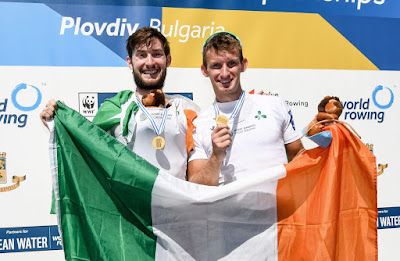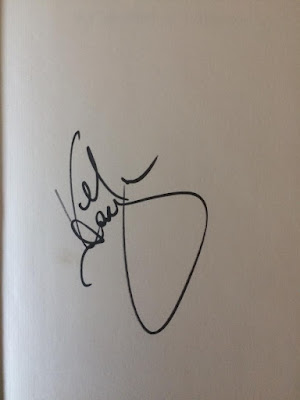Detail from Joan Blaeu's 1655 'Atlas Major' featuring the West Cork region. Mizen Head, Roaring Water Bay and 'Carbery's Hundred Isles' dominate the lower half of the map, with Bantry Bay being the primary feature of the upper half. Among the ancient Irish clans referenced here are the O'Driscolls, O'Mahonys, O'Donovans and MacCarthys and these are still some of the most prominent surnames in West Cork.
The Sportyman2020 team were on holiday this past week in deepest West Cork so I am posting a briefer than usual piece, involving a melange of sporting related bits.
The sporting references started on our journey southwest, passing the famed Skibbereen Rowing Club, home to the O'Donovan brothers who have won multiple medals at European, World and Olympic levels.
Paul and Gary O'Donovan
On Thursday we were on the trail of The Blonde’s ancestors, so we made our way to Whiddy Island in Bantry Bay. Tim O’Leary is the ferryman and generally accepted as ‘Mr. Whiddy Island’. He is also the uncle of Irish rugby international and British and Irish Lion Tadhg Furlong and he was involved in a Second Captains Live show from a few years back. Here’s the link to the show:
https://www.secondcaptains.com/2017/06/26/episode-890-second-captains-live-whiddy-island/
Our view from the fort at the northern end of Whiddy Island, looking east towards the mainland and Chapel Island (which becomes two islands in high tide, as seen in this photo)
Whiddy Island was especially beloved of my father-in-law, where he returned many summers to work on his mother’s family farm. One of his sons went on to become an accomplished rower, winning multiple races up and down the West Cork coast and he is now an island man too, raising his own family in Mallorca. And happy birthday to his own son, who turns 18 today.
Despite being only approximately 5 km x 1.5 km in size, Whiddy's strategic importance in Bantry Bay means that it has a rich and storied history, from O'Sullivan Beare (1561-1613) through to Cromwell, an attempted French invasion in 1796 to assist the United Irishmen in their fight against the British and right up to World War I when the island was used as a United States naval air station. In more recent times, the Whiddy Island disaster of 1979 involved the explosion of the oil tanker Betelgeuse and the deaths of fifty people. Here's a link for more background on the island:
https://explorewestcork.ie/islands/whiddy-island/
O'Sullivan Beare (1561-1618)
'A View of the Bay of Bantry', by Thomas Phillips (1725),
with Whiddy Island in the centre
Statue of Theobald Wolfe Tone (1763-1798) in Wolfe Tone Square, Bantry. Tone was one of the founders and leaders of the United Irishmen, who were committed to more independence from Britain and 'principles of civil, political and religious liberty'.
Anchor from a ship of the ill fated 1796 'French Armada', which attempted an invasion via Bantry Bay in support of Wolfe Tone and his United Irishmen allies in their uprising against the British
Although named after an Irish patriot who bravely took on the English, Wolfe Tone Square in Bantry also has a recently erected memorial to an Englishman much loved by the Irish - see also the recent blog by another island man, Philip Finnegan: https://sportyman2020.blogspot.com/2020/07/thanks-jack.html
Sport on Whiddy Island
As soon as we set foot on Whiddy Island, I came across the information sign below that includes references to Whiddy’s illustrious sporting past. For ease of reading, I have transcribed beneath the image of the sign the author’s (at times tongue in cheek) accounts of GAA, Bowling, Rowing and Tug-o-war on Whiddy. The vagaries of island life means that there has been a steady decline in the population from 729 in 1841 to the current level of only 20 permanent residents and Whiddy's sporting exploits are now all history. But as you can see below, the Whiddy diaspora continue to excel in various sports on the mainland.
Transcription from the above sign relating to Whiddy Island's sporting past
GAA
It
is known that Whiddy Island once had two football teams, The East and The West.
The West’s pitch called the Crock was situated in Kilmore, while the East’s
pitch was at the bottom of The Bullock’s field in Trawnaha. A keen rivalry
existed between both teams and many a tough match ensued. Many a player went
home with bruises or knocks as they are called nowadays. But those were the
days when hamstrings, quad muscles and tweaks were unheard of and no matter how
sore a player was it was back to work afterwards. Whether it was farming or
fishing the show had to go on. In later years Whiddy Island sent teams to the
mainland to play various townlands in Bantry’s hinterland. In one account of
such a game against Scart apparently it was the following day before some of
the casualties were located.
Nowadays
due to the population decline GAA players from the island play hurling and
football with Bantry Blues. However every year there is an All Ireland Islands
Football Tournament which Whiddy participates in with the help of some players
of island descent, who are very proud to play for the land of their
fathers and mothers. In fact Whiddy Island won the competition in 2015, which
was held on Inishturk. Players from Whiddy Island have served with distinction
on West Cork (Carbery) and in Cork County selections in the past.
Road Bowling
Whiddy
people have participated in road bowling over the years, both on the island and
on the mainland. Apparently three bowls from the school to the bank was the yardstick
by which you were judged fit to be presented for a ‘score’ in Bantry. Whiddy
Island players have won various West Cork and county medals at road bowling
over the years.
Rowing
It
was probably in rowing that Whiddy Island excelled most over the years. The
island has had many famous wins, the most renowned, probably, was the crew who
beat the famous Casey brothers from Sneem (who went on to conquer the world).
Rowing was second nature to all Whiddy Islanders, who had to row to the fishing
grounds, to mass or shopping in Bantry. In fact races often developed between
Islanders on their way home from Bantry whose endeavours were fortified by the
hospitality in the town that day. Whiddy Island crews were feared everywhere
they raced and provided Islanders with great enjoyment and pride at regattas in
places like Bantry, Castletownbere, Sneem, Schull or Kenmare. There was one
famous race which took place at Bantry regatta in the 1950s with two Whiddy
gigs participating. Whiddy took first and second in this race. It was so famous
at the time that a song was written about it by Denis Burke (Crowangle North)
which was printed on The Southern Star.
Tug-o-war
Whiddy
Island has participated in tug-o-war competitions at various times over the
years, and just as in other sports they have been extremely competitive. In
fact at one tug-o-war which took place in the 1950s, one pull which had lasted
half an hour made the local priest so concerned that he wanted to cut the rope,
but he was told by the Whiddy men that if he did they would cut his throat.
Whiddy went on to win the pull, amid great scenes of jubilation.
Just a few miles from Whiddy we discovered in Ballydehob the story of Danno
O’Mahony (1912-1950) who was Heavyweight World Wrestling Champion in 1935-1936.
Here’s a link to Joe O’Shea’s 2015 blog on the great Danno:
http://josefoshea.blogspot.com/2015/02/danno-omahony-almost-undisputed.html
Ballydehob's own Danno O'Mahony (1912-1950)
Finally, I can't finish this week's blog without mentioning sporting events on one of Ireland's other offshore islands, when a certain trophy was (finally and at long last) presented on Wednesday night to the world's greatest football team.












































